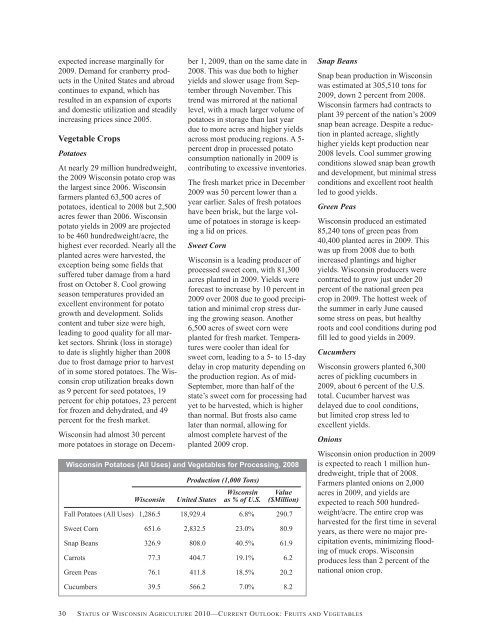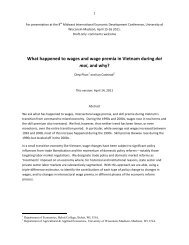Status of Wisconsin Agriculture 2010 - Agricultural & Applied ...
Status of Wisconsin Agriculture 2010 - Agricultural & Applied ...
Status of Wisconsin Agriculture 2010 - Agricultural & Applied ...
Create successful ePaper yourself
Turn your PDF publications into a flip-book with our unique Google optimized e-Paper software.
expected increase marginally for<br />
2009. Demand for cranberry products<br />
in the United States and abroad<br />
continues to expand, which has<br />
resulted in an expansion <strong>of</strong> exports<br />
and domestic utilization and steadily<br />
increasing prices since 2005.<br />
Vegetable Crops<br />
Potatoes<br />
At nearly 29 million hundredweight,<br />
the 2009 <strong>Wisconsin</strong> potato crop was<br />
the largest since 2006. <strong>Wisconsin</strong><br />
farmers planted 63,500 acres <strong>of</strong><br />
potatoes, identical to 2008 but 2,500<br />
acres fewer than 2006. <strong>Wisconsin</strong><br />
potato yields in 2009 are projected<br />
to be 460 hundredweight/acre, the<br />
highest ever recorded. Nearly all the<br />
planted acres were harvested, the<br />
exception being some fields that<br />
suffered tuber damage from a hard<br />
frost on October 8. Cool growing<br />
season temperatures provided an<br />
excellent environment for potato<br />
growth and development. Solids<br />
content and tuber size were high,<br />
leading to good quality for all market<br />
sectors. Shrink (loss in storage)<br />
to date is slightly higher than 2008<br />
due to frost damage prior to harvest<br />
<strong>of</strong> in some stored potatoes. The <strong>Wisconsin</strong><br />
crop utilization breaks down<br />
as 9 percent for seed potatoes, 19<br />
percent for chip potatoes, 23 percent<br />
for frozen and dehydrated, and 49<br />
percent for the fresh market.<br />
<strong>Wisconsin</strong> had almost 30 percent<br />
more potatoes in storage on Decem-<br />
ber 1, 2009, than on the same date in<br />
2008. This was due both to higher<br />
yields and slower usage from September<br />
through November. This<br />
trend was mirrored at the national<br />
level, with a much larger volume <strong>of</strong><br />
potatoes in storage than last year<br />
due to more acres and higher yields<br />
across most producing regions. A 5percent<br />
drop in processed potato<br />
consumption nationally in 2009 is<br />
contributing to excessive inventories.<br />
The fresh market price in December<br />
2009 was 50 percent lower than a<br />
year earlier. Sales <strong>of</strong> fresh potatoes<br />
have been brisk, but the large volume<br />
<strong>of</strong> potatoes in storage is keeping<br />
a lid on prices.<br />
Sweet Corn<br />
<strong>Wisconsin</strong> is a leading producer <strong>of</strong><br />
processed sweet corn, with 81,300<br />
acres planted in 2009. Yields were<br />
forecast to increase by 10 percent in<br />
2009 over 2008 due to good precipitation<br />
and minimal crop stress during<br />
the growing season. Another<br />
6,500 acres <strong>of</strong> sweet corn were<br />
planted for fresh market. Temperatures<br />
were cooler than ideal for<br />
sweet corn, leading to a 5- to 15-day<br />
delay in crop maturity depending on<br />
the production region. As <strong>of</strong> mid-<br />
September, more than half <strong>of</strong> the<br />
state’s sweet corn for processing had<br />
yet to be harvested, which is higher<br />
than normal. But frosts also came<br />
later than normal, allowing for<br />
almost complete harvest <strong>of</strong> the<br />
planted 2009 crop.<br />
<strong>Wisconsin</strong> Potatoes (All Uses) and Vegetables for Processing, 2008<br />
Production (1,000 Tons)<br />
<strong>Wisconsin</strong> United States<br />
<strong>Wisconsin</strong><br />
as % <strong>of</strong> U.S.<br />
Value<br />
($Million)<br />
Fall Potatoes (All Uses) 1,286.5 18,929.4 6.8% 290.7<br />
Sweet Corn 651.6 2,832.5 23.0% 80.9<br />
Snap Beans 326.9 808.0 40.5% 61.9<br />
Carrots 77.3 404.7 19.1% 6.2<br />
Green Peas 76.1 411.8 18.5% 20.2<br />
Cucumbers 39.5 566.2 7.0% 8.2<br />
30 STATUS OF WISCONSIN AGRICULTURE <strong>2010</strong>—CURRENT OUTLOOK: FRUITS AND VEGETABLES<br />
Snap Beans<br />
Snap bean production in <strong>Wisconsin</strong><br />
was estimated at 305,510 tons for<br />
2009, down 2 percent from 2008.<br />
<strong>Wisconsin</strong> farmers had contracts to<br />
plant 39 percent <strong>of</strong> the nation’s 2009<br />
snap bean acreage. Despite a reduction<br />
in planted acreage, slightly<br />
higher yields kept production near<br />
2008 levels. Cool summer growing<br />
conditions slowed snap bean growth<br />
and development, but minimal stress<br />
conditions and excellent root health<br />
led to good yields.<br />
Green Peas<br />
<strong>Wisconsin</strong> produced an estimated<br />
85,240 tons <strong>of</strong> green peas from<br />
40,400 planted acres in 2009. This<br />
was up from 2008 due to both<br />
increased plantings and higher<br />
yields. <strong>Wisconsin</strong> producers were<br />
contracted to grow just under 20<br />
percent <strong>of</strong> the national green pea<br />
crop in 2009. The hottest week <strong>of</strong><br />
the summer in early June caused<br />
some stress on peas, but healthy<br />
roots and cool conditions during pod<br />
fill led to good yields in 2009.<br />
Cucumbers<br />
<strong>Wisconsin</strong> growers planted 6,300<br />
acres <strong>of</strong> pickling cucumbers in<br />
2009, about 6 percent <strong>of</strong> the U.S.<br />
total. Cucumber harvest was<br />
delayed due to cool conditions,<br />
but limited crop stress led to<br />
excellent yields.<br />
Onions<br />
<strong>Wisconsin</strong> onion production in 2009<br />
is expected to reach 1 million hundredweight,<br />
triple that <strong>of</strong> 2008.<br />
Farmers planted onions on 2,000<br />
acres in 2009, and yields are<br />
expected to reach 500 hundredweight/acre.<br />
The entire crop was<br />
harvested for the first time in several<br />
years, as there were no major precipitation<br />
events, minimizing flooding<br />
<strong>of</strong> muck crops. <strong>Wisconsin</strong><br />
produces less than 2 percent <strong>of</strong> the<br />
national onion crop.







